Last updated: June 19, 2019
Article
A Red Bolt from the Blue: Valery Chkalov and the World's First Transpolar Flight

NPS Photo
In a huge, glider-like airplane above Eugene, Oregon, Valery Chkalov and his crew realized they were running out of fuel and would not make it to Oakland, California, as planned. Chkalov told his copilot, Georgi Baidukov, to turn the ANT-25 back towards Portland. Droplets of rain glistened on Baidukov's face as he leaned out the cockpit window. "I need the detailed map," he shouted to navigator Alexander Belyakov. "That's it," Chkalov whispered a short time later, as he gazed at photos of American airports and recognized the bridges and factories below.
AMERICA! Sixty-three hours and sixteen minutes from the time they left Moscow, the world's first transpolar flight landed safely at Pearson Field. This dangerous, fantastic flight matched the glitz and glamor of Earhart and Lindbergh, but few in America would realize its lasting impact. Three men endured incredible cold, hazards, exhaustion, and a lack of oxygen to fly over the North Pole, setting world records in the process.
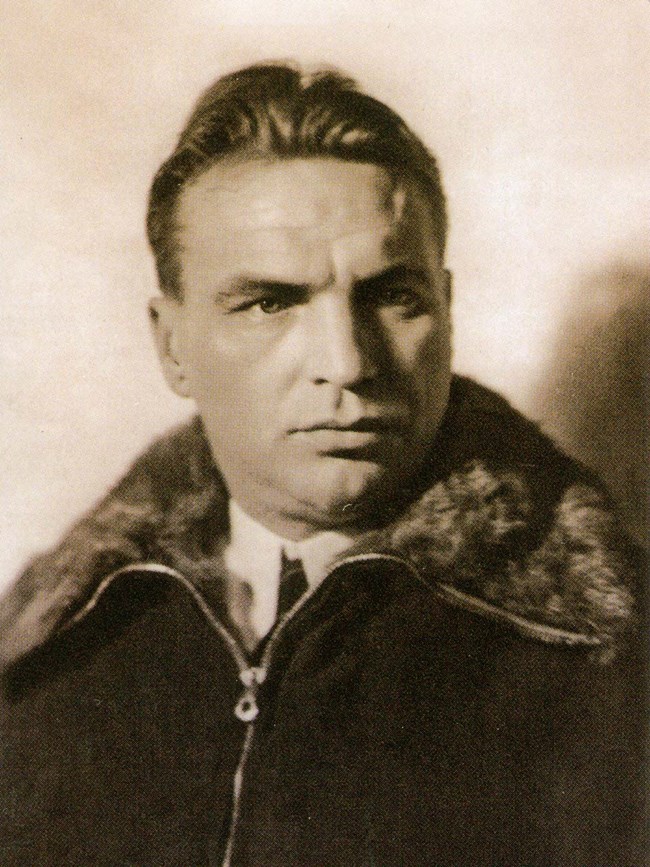
NPS Photo
Three Brave Flyers
Valery Pavlovich Chkalov, Pilot (1904-1938)
Chkalov was a daring Russian pilot born in the village of Vasilova Sloboda, later renamed Chkalovsk in his honor. He worked as a bargeman on the Volga, loving the river and its people, but he longed to take to the sky. As a test pilot and flight instructor, Chkalov continually challenged his fears in order to overcome them. He performed rolls, Immelmann turns, and vertical climbs with extraordinary talent. Fearless, headstrong, and gregarious by nature, Chkalov was best known for takeoffs and landings that prepared him to master the icy regions of the Far North.
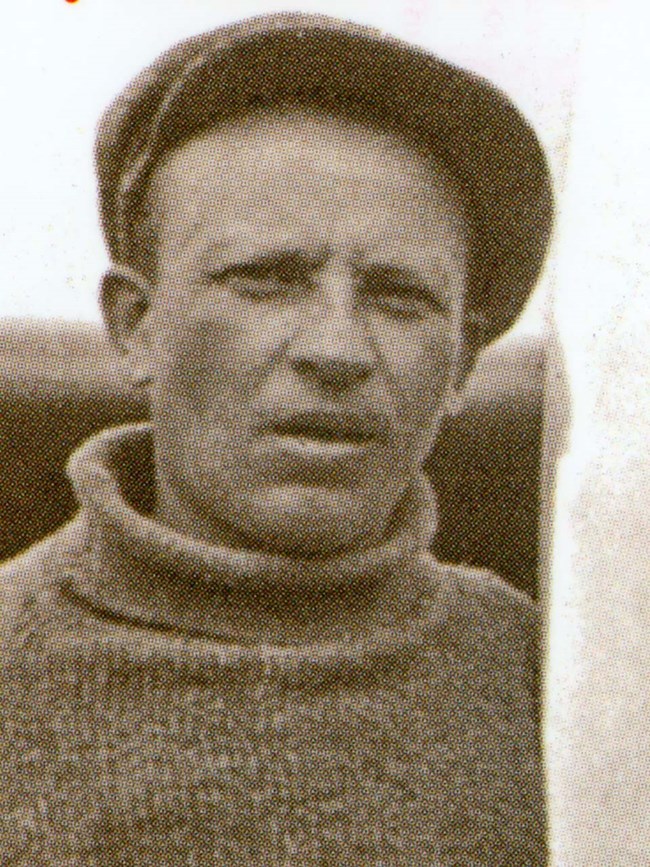
NPS Photo
Affectionately called "Baiduk" by Chkalov, Georgi Baidukov was born in the Taryshta Train Station where his mother worked for the railway in Novosibirisk Oblast. He was orphaned at age nine. After receiving basic education in an orphanage, he graduated from the Air Force Technical School and Kacha School for military pilots in 1928. An avid writer and a studious, organized pilot, Baidukov became a test pilot with a keen interest in long distance flying. He first tried to reach the North Pole with Sigizmund Levanevski's crew in 1935. Baidukov helped organize the transpolar crew in 1936, joining Chkalov and Belyakov for a flight through Russia to Udd Island, also in an ANT-25. For this flight, all three fliers were honored Heroes of the Soviet Union.
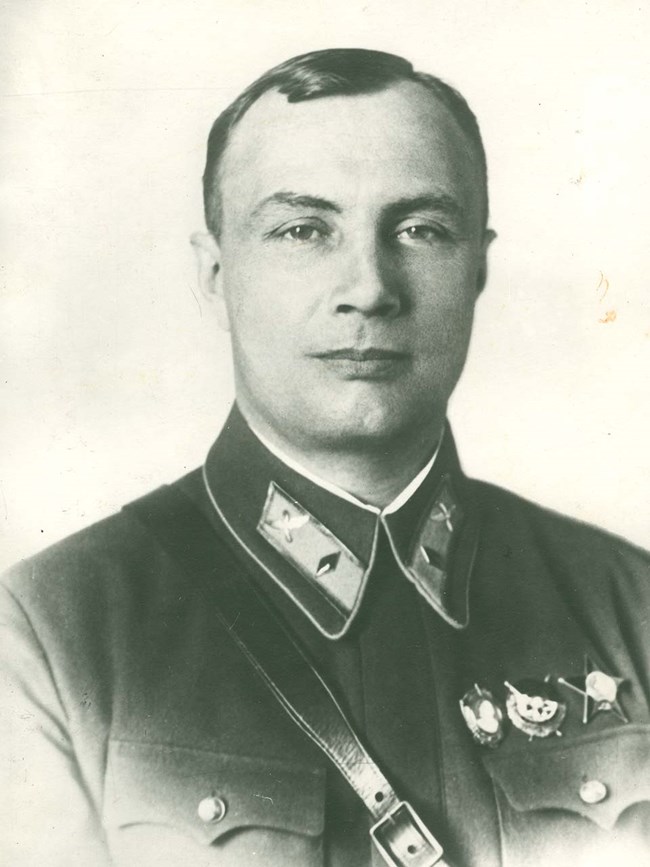
NPS Photo
Born in the village of Bezzubovo, Moscow Governorate (now Orekhovo-Zuyevsky District, Moscow Oblast), Belyakov grew up in Ryazan. He studied forestry until he joined the infantry of the Imperial Russian Army in 1916 and fought in the Russian Civil War. He graduated from the Moscow Aerophotogrammetry School of the Red Air Fleet in 1921. He taught there and at the A.E. Zhukovsky Air Force Academy until 1935, when he graduated from the Kachinskoye Military Aviation School for Pilots. Belyakov was considered one of Russia's most outstanding navigators in the 1930s, and was selected for the North Pole flight due to his skill and calm presence. The crew depended upon his calculations and confidence as they flew to America without a magnetic compass, reliable charts, or consistent radio communication to identify their bearings.
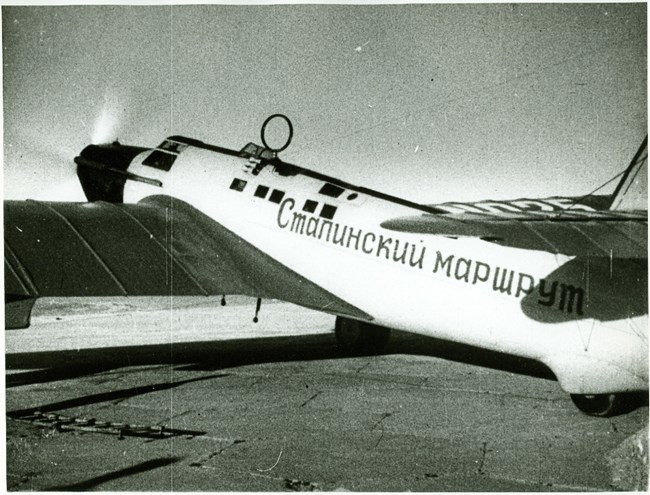
Von Hardesty Photo Collection
Into the Unknown
"Our flight is purely experimental. If we are the first to establish an air link over the pole between the Old World and the new, it will be a record, but we are not primarily seeking records."
- Valery Chkalov, Moscow, June 17, 1937
In 1937, Chkalov worked as a flight instructor, Baidukov as a research test pilot, and Belyakov as a navigation instructor. In preparation for the transpolar flight, the three men met in the evenings for long discussions about flying in the north, the history of polar expeditions, and survival in the Arctic. Through the "white nights" of spring in Russia, they flew the ANT-25, learning details that would help them accomplish long distance goals.
The team petitioned for permission to fly the length of the continent, from Moscow to the Far East, in an ANT-25. The word spread to factories throughout the region that supplies were needed for a spectacular flight and provisions began to collect in their barracks.
Chkalov recalled: "The adjoining room had begun to look like a junk store. This was where they brought all of their equipment and foodstuffs for the flight. There were full-skirted fawn fur coats, boots of reddish dog fur, men's cologne, rucksacks with knitted silk underwear, tinned chicken, apples, lemon wafers, delicious whole-wheat crackers that melted in your mouth, a small ax, lighters, tobacco, cans of cocoa, cross-country skis, smoked sausage, rifles, aspirin, a primus stove, cans of ox tongue, ropes, Finnish knives, aluminum pans, velveteen jackets and much more."
Takeoff was on a clear July morning. They flew east over Chkalov's native village of Vasilova Sloboda before the countless blocks of ice began and boredom and drowsiness set in. This flight, covering more than 9,374 km, set a record for the longest nonstop flight yet, and prepared the crew for a flight across the North Pole. After 56 hours, they landed at Udd Island, which was renamed "Chkalov Island." A week after landing, they managed to clear an airstrip on the ice and took off for a heroic return to Moscow.
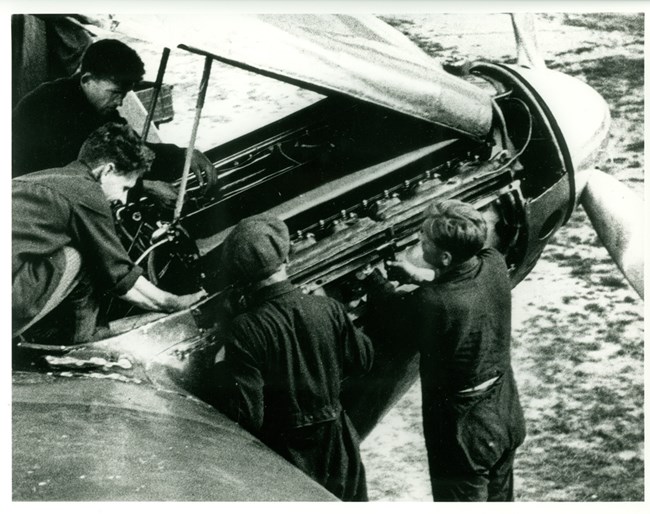
Von Hardesty Photo Collection
Conquest of the Roof of the World
In 1937, the public both feared and was fascinated with aviation. The interest in Chkalov and other long distance pilots was intense.
Russia's interest in the North Pole was driven by economic prospects and the opportunity for technological advancement. A northern sea route would allow passage of commercial and war ships, and would establish refueling and supply stations for ships and aircraft in remote areas. For navigation, meteorological stations were built providing better weather forecasting for northern Europe and Asia.
Weather, temperature, and reliance on aviation gauges were key elements in the first transpolar flight. Once over the Pole, the Chkalov crew encountered stormy, cold weather, throwing the ANT-25 off course and burning more fuel as they tried to fly above the storm. Baidukov and Chkalov slept in shifts as they manned the controls, while Belyakov took short naps to stay alert to navigation needs. Ice formed unevenly, endangering structural integrity and weighing down the aircraft. The higher they flew, the greater the crew's demand for oxygen. Baidukov prevailed by "flying blind" with instruments only. They were an excellent team. With Chkalov's steady guidance, Belyakov's expert navigation, and Baidukov's skills, they flew 5,288 miles through white skies and over unfamiliar territories. Through diplomatic arrangement, Russian and American meteorologists and radio operators communicated with the crew throughout the flight, though the fliers reported reception difficulties several times.
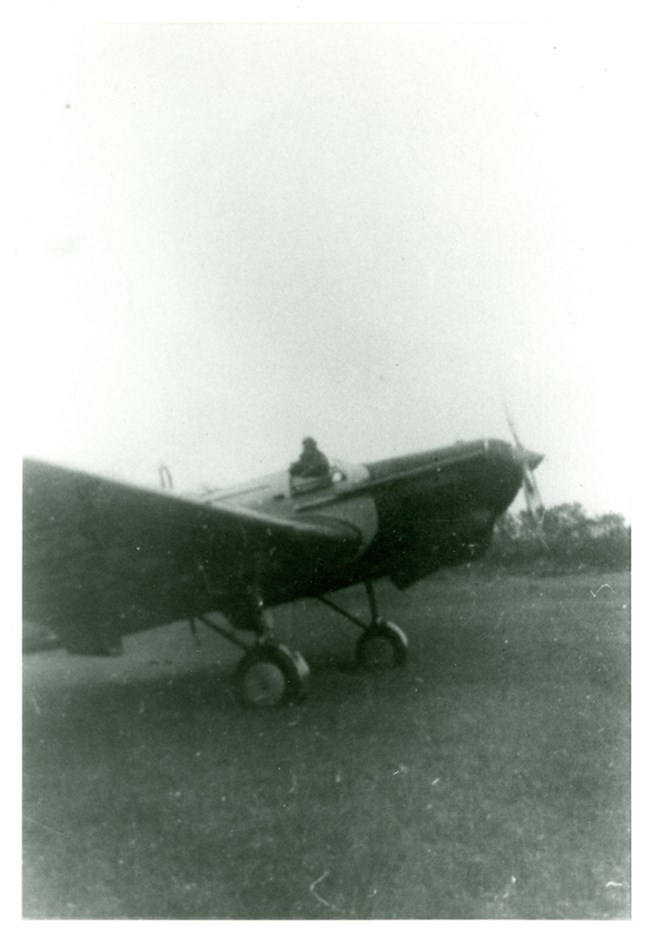
Morris Gillis Collection
AMERICA!
"Those are the bridges and factories [of Portland], I'm sure of it!"
- Valery Chkalov, June 20, 1937
Flying south over Eugene, Oregon, as they headed for Oakland, California, where the Russian ambassador awaited them, the crew realized their fuel was running dangerously low. Chkalov told Baidukov to turn back towards Portland. The aircraft, its red wings looming dully in the haze, suddenly broke through the curtain of rain. Below them was Swan Island Airport in Portland, crowded with excited Americans waving flags and hoping to witness the landing. Remembering how a zealous crowd wanting souvenirs had destroyed Lindbergh's plane in 1927, and worried that the ANT-25 would suffer the same fate, Chkalov ordered his crew to continue north across the Columbia River. They soon spotted a narrow, green strip of land stretching beneath them, with buildings resembling hangars dotting the field. Baidukov made a quick estimate of the field's length (about one-third the ideal) and possible approaches. He went into a banked turn and the plane's wing tip nearly touched the fir trees.
Chkalov shouted, "Land at the very edge!" He feared the plane might crash into a fence or sink into soft soil. But they touched down smoothly in the morning drizzle, wings quivering slightly. The ANT-25 rolled to a stop about 200 meters from the edge of the airfield. The brakes had been removed from the plane to save weight, but its flaps helped reduce landing speed.
"We've landed. We're on the ground," Chkalov pronounced quietly. "This is America..."
His friends were silent. Baidukov was feverish, his face drawn and his eyes bloodshot. He opened the hatch and hot damp air quickly filled the cockpit. He gave a deep sigh and rested his weary head on the control wheel. He could feel his heart beating wildly. Belyakov was slowly packing his maps into a briefcase.
"Sasha, we've landed!" Chkalov shouted to Belyakov, rushing over to the window. The navigator continued to tidy up, putting away triangles, compasses, and pencils. "You fellows can do what you like, but I'm climbing out!"
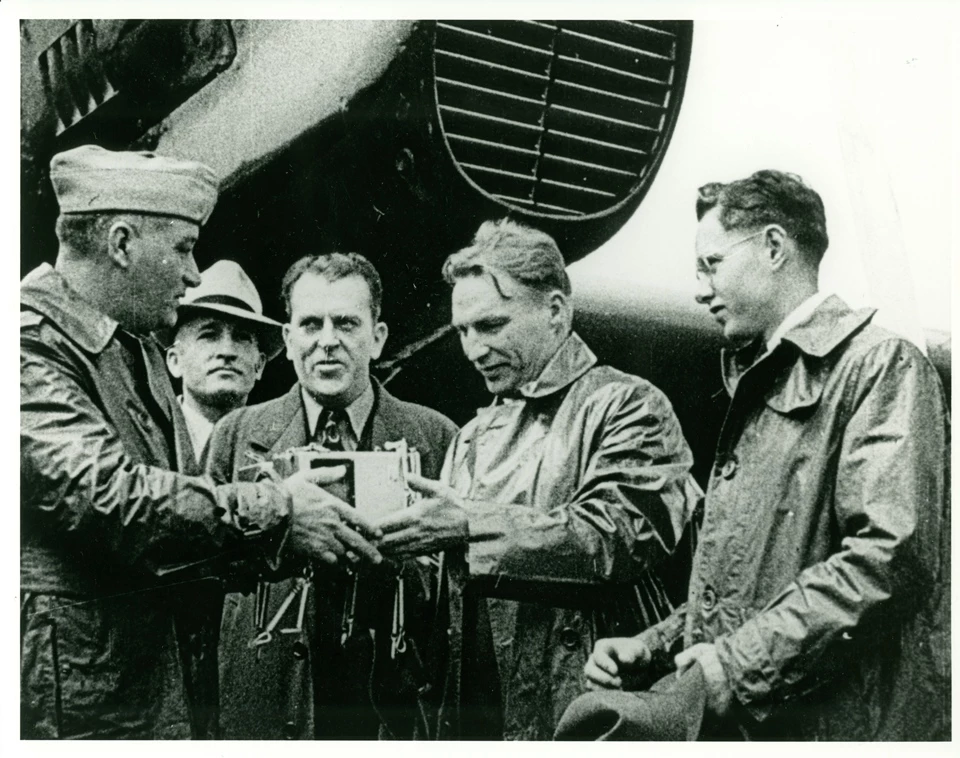
Leverett G. Richards Collection
World Renown, Local Heroes
The morning of Sunday, June 20, General George C. Marshall was startled by the ring of his telephone. The voice of local mechanic R.F. Spender at Pearson Field was shaking and excited. "It's that plane, Sir! That big Russian plane! It's landed here!"
The general called for his driver and within a few minutes they were headed across the Vancouver Barracks Parade Ground, bumping through the officers' golf course and making straight for the ANT-25 at rest on Pearson Field. The quick-thinking guards rousted Russian speaking ROTC student George Kotzmetsky from the barracks, who now stood prepared to interpret for the general's staff and the three fliers.
Chkalov was out of the plane, talking with a gathering crowd of curious onlookers. As Marshall arrived, Chkalov banged on the side of the plane and called for his crew to come out. "Sasha! Baiduk! General Marshall is here, come meet him." Perplexed, Baidukov asked Belyakov, "I don't understand, is he a general or a marshal?"
"I can't say," replied Belyakov. "I don't know if the Americans have marshals, but they certainly have generals! Time to go."
By now, dozens of people were gathering at the edge of the field. Cars were crossing the bridge from Portland, and General Marshall ordered his men to secure the ANT-25 from the crowd. He escorted the weary heroes to his car for the ride to his home on Officers' Row. After food and rest, the re-energized crew returned to the ANT-25 to speak with reporters and to remove the sealed flight barograph.
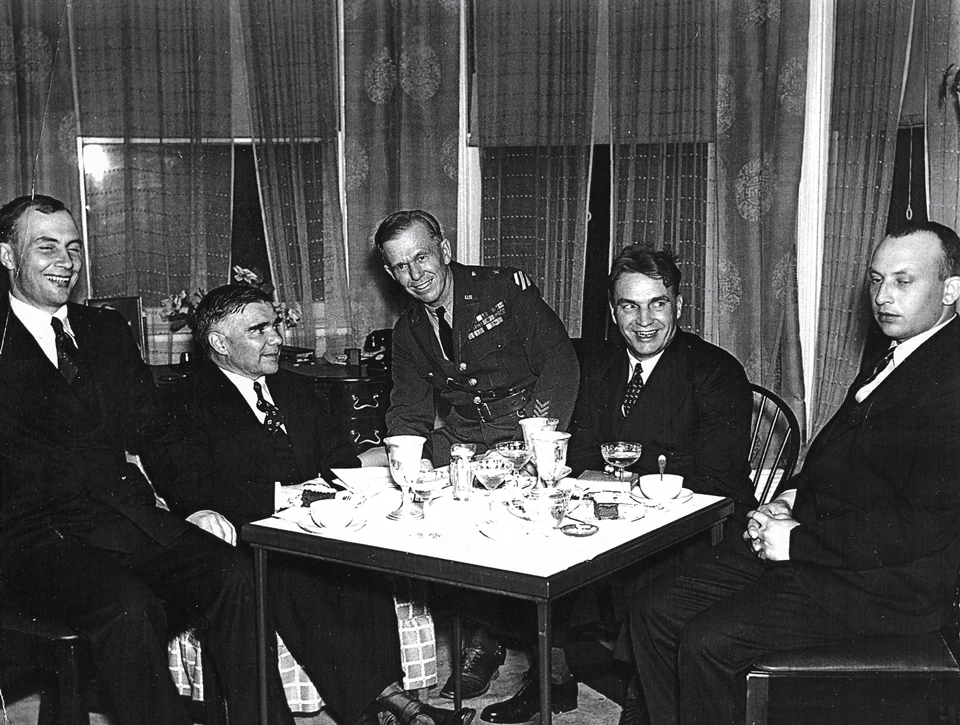
NPS Photo
A Lasting Tribute
"We brought friendship on the wings of that plane."
- Georgi Baidukov, 1975, at Vancouver, Washington
Soon after the flight in 1937, a small group of community leaders - led by the Vancouver Chamber of Commerce and the Clark County Sun - sent a formal letter to Josef Stalin requesting that relations be established between Russia and Vancouver, Washington. No reply was received, but 56 years later the letter was discovered in the Russian diplomatic archives.
In 1974, two Russian sailors docked at the Port of Vancouver, and asked for directions to the monument honoring Chkalov and his crew. Though there was no such monument at the time, this request invigorated local interest in the famous flight that had ended at Pearson Field 37 years before. By the next year, a monument honoring the fliers was unveiled to a crowd that included Baidukov and Belyakov. Chkalov, who had died during a test flight just a year after the transpolar achievement, was represented by his son Igor and daughters Valeria and Olga.
A grand celebration was held again during the 50th anniversary of the flight in 1987. Family members of the pilots visited Vancouver, and delegations of interested Vancouver citizens, including members of the Chkalov Cultural Exchange Committee, visited Moscow.
Each year, the National Park Service and its partners celebrate the legacy of the transpolar flight that landed at Pearson Field, and the connection it established between Vancouver and Russia.

NPS Photo by Troy Wayrynen
Tags
- fort vancouver national historic site
- aviation
- aviation firsts
- aviation history
- aviation places
- russian america
- russian american history
- russian
- soviet union
- aviator
- pearson air museum
- vancouver
- vancouver barracks
- vancouver washington
- people
- transportation history
- international relations
- historic aviation locations
